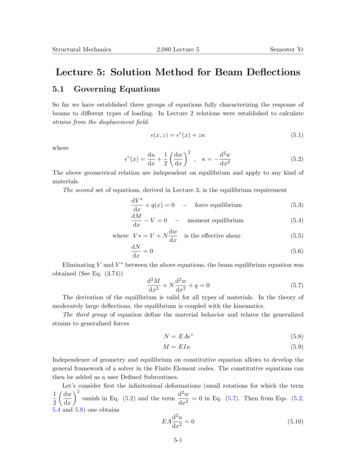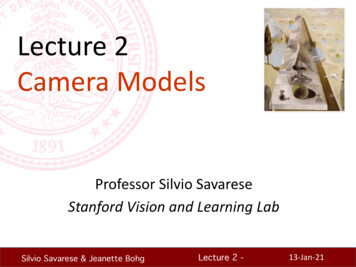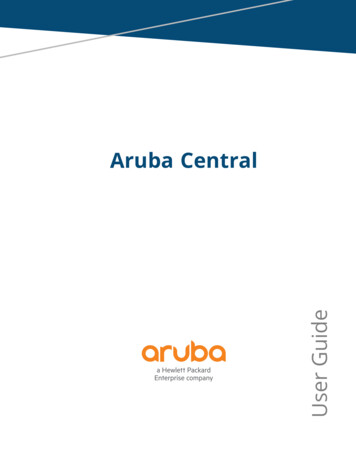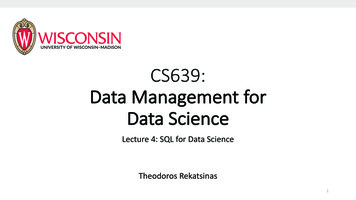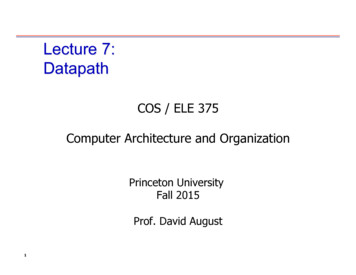
Transcription
Lecture 7:DatapathCOS / ELE 375Computer Architecture and OrganizationPrinceton UniversityFall 2015Prof. David August1
DatapathDatapathThe component of the processor that performsarithmetic operations – P&HDatapathThe collection of state elements, computation elements,and interconnections that together provide a conduit forthe flow and transformation of data in the processorduring execution. - DIA5
6
Datapath - Part of the MicroarchitectureArchitecture The ISA - the programmer s view of the machine Implementation independent, an interfaceMicroarchitecture The lower-level implementation of the ISA Design specific, an implementationExample use of terminology Architectural state: Register r5 Microarchitectural state: Carry bit on the 5th 1-bit ALU7
Datapath Elements ALUs are just one datapath building block What about the other elements?Computational Elements Combination Circuits Outputs follow inputs Familiar Example: ALUState Elements Sequential Circuits Outputs change on clock edge Familiar Example: A Register8
Computation Element: ALU Combinational - you had better know how to design it by now!!! Refine for MIPS Zero equality test on all results - why? Set on less than for slt instruction3A L U co n t ro lALUZeroResultALU ControlFunction000AND001OR010add110subtract111set on less than
Computation Element: Sign Extender 16 à 32 bit Sign extender Why is this necessary in MIPS?16SignExtend Hint:Implementation?32
Computation Element: Adder Not an ALU, just add Why would we need this in MIPS to execute instructions?Add Sum
Computational Element: The Magical Mux Mux is short for Multiplexer (Think: selector)n input lines (of any common width)m control wires to selectn 2mControlmin0innMuxImplementation?12out
State Element: Register File Microarchitecture to implement architectural state Built using D flip-flops MIPS: Need to be able to read two operands at once 2 source operands per instruction5Reg isternumbers55DataReadre gister 1Readre gister 2Reg iste rsWritere gisterWritedataRe addata 1DataRe addata 2Reg Write5-bits? 2 Reads? 1 Write?
State Element: Register FileRegister ImplementationD latchFalling edge triggered D flip-flop14
State Element: Register FileRead Implementation5Reg is te rnu m b e r s55DataRea dre gi st e r 1Rea dre gi st e r 2Reg is te rsWritere gi st e rWrited a taRe add at a 1DataRe add at a 2Reg Write
State Element: Register FileWrite Implementation5Reg is te rnu m b e r s55DataRea dre gi st e r 1Rea dre gi st e r 2Reg is te rsWritere gi st e rWrited a taRe add at a 1DataRe add at a 2Reg WriteKnow decoders
State Element: Data and Instruction Memory Microarchitectural element to hold the architecturalmemory state See Appendix B for implementation nInstructionmemor yWriteda taReaddataDa tamemoryMemRead17
State Element: The Program Counter To hold the architectural PC state Just like a single registerPC18
Our Complete Line of Products!There may be others, but this is good for MIPSMe m WriteInstructio naddressAddre ssPCInstructio nReaddataAdd SumDa tamemoryWriteda taInstructionmemoryMe mRead5Reg isternumbers55Data3Readregister 1Readdata 1Readregister 2Reg istersWriteregisterReaddata 2WritedataReg WriteDataControlmALU controlZe roALU ALUresultin0innMux16outSignex te nd32
Fetching Instructions (no branching)21
The ALU (R-Type) InstructionsConsider: r1 r2 - r322
Load and Store InstructionsConsider: r1 M[ r2 - 3 ]23
Composition of Memory and R-Type DatapathThe Magic of the Mux24
Recall Fetch25
Now Add Instruction Fetch26
Now Add Instruction Fetch(ALU MEM Fetch)Data and Instruction memory?27
Branch InstructionsWhy shift left by 2?Consider: Branch r1 0, TARGET28
Add Branch to Datapath(ALU MEM Fetch Branch)What will zero be connected to?29
MIPS Instruction Quirk The Destination Register may be in different locations 11-15: Loads use rt 16-20: All R-Types use rd30
Again, The Magic of the Mux!31
Ugh, what is going on here!?!32
Control vs. Datapath (Blurring the Line)33
What is Control?ControlThe component of the processor that commands thedatapath, memory, and I/O devices according to theinstructions of the program. – P&HControlThe component of the processor that commands thedatapath, memory, and I/O devices according to theinstructions of the program. - DIA34
Full Datapath with Control35
36
Summary and Next Steps The book doesn t define datapath wellComputation and State elements compose datapathLook for reuse across instruction typesBuild minimal HW datapath with the magic of the muxNext Steps Need to define control Understand Timing Single cycle Multi-cycle Understand how to implement control37
For Next Time Review finite state machines:38
The book doesn t define datapath well Computation and State elements compose datapath Look for reuse across instruction types Build minimal HW datapath with the magic of the mux Next Steps Need to define





